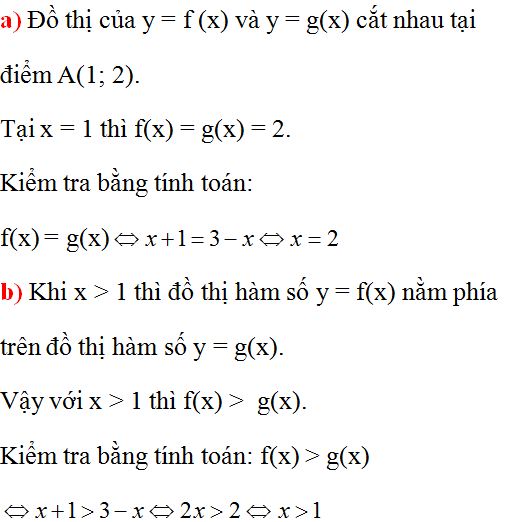Hãy nhập câu hỏi của bạn vào đây, nếu là tài khoản VIP, bạn sẽ được ưu tiên trả lời.

a) f(x) = (x+2)(x-1)
f(x) > 0 với x < -2 hoặc x > 1
f(x) ≤ 0 với -2 ≤ x ≤ 1
b) y = 2x (x + 2) = 2(x+1)2 – 2
Bảng biến thiên:

Hàm số : y = \(\left(x+2\right)\left(x+1\right)=\left(x+\dfrac{3}{2}\right)^2-\dfrac{1}{4}\)
Bảng biến thiên :

Đồ thị (C1) và (C2)

Hoành độ các giao điểm A và B của (C1) và (C2) là nghiệm của phương trình f(x) = 0 ⇔ x1 = -2, x2 = 1
⇔ A(-2, 0) , B(1, 6)
c) Giải hệ phương trình
\(\left\{{}\begin{matrix}\dfrac{ac-b^2}{4a}\\a\left(-2\right)^2+b\left(-2\right)+c=0\\a\left(1\right)^2+b\left(1\right)+c=6\end{matrix}\right.\Leftrightarrow\left\{{}\begin{matrix}a=-2,b=0,c=8\\a=-\dfrac{2}{9},b=\dfrac{16}{9},c=\dfrac{40}{9}\end{matrix}\right.\)

Lời giải
a) c/m \(f\left(x\right)=x^2-ax-3bc+\dfrac{a^2}{3}>0\forall x\)
\(\Delta_{x_{a,b,c}}=a^2+12bc-\dfrac{4}{3}a^2=\dfrac{-a^2+36bc}{3}\)
\(\Delta=\dfrac{-a^3+36}{3a}\)
\(a^3>36\Rightarrow\left\{{}\begin{matrix}a>0\\-a^3+36< 0\end{matrix}\right.\) \(\Rightarrow\dfrac{-36a^3+36}{3a}< 0\)
\(\Rightarrow\) F(x) vô nghiệm => f(x)>0 với x => dpcm
b)
\(\dfrac{a^2}{3}+b^2+c^2>ab+bc+ca\)\(\Leftrightarrow\dfrac{a^2}{3}+b^2+c^2-ab-bc-ac>0\)
\(\Leftrightarrow\left(b+c\right)^2-a\left(b+c\right)-3bc+\dfrac{a^2}{3}>0\)
Từ (a) =>\(f\left(b+c\right)=\left(b+c\right)^2-a\left(b+c\right)-3bc+\dfrac{a^2}{3}>0\) => dccm

\(f\left(5\right)=-5^2+2.5=-15\)
\(f\left(-2\right)=-\left(-2\right)^2+2.\left(-2\right)=-8\)
\(f\left(2\right)=-2^2+2.2=0\)

Lời giải:
\(f(x)=(-x+1)(x-2)>0\Leftrightarrow \left\{\begin{matrix} -x+1< 0\\ x-2< 0\end{matrix}\right.\) hay $1< x< 2$
hay $x\in (1;2)$
Đáp án D

gọi T là tập hợp giá trị của F
\(\begin{cases}\sqrt[3]{x}\left(\sqrt[3]{x}-1\right)+\sqrt[3]{y}\left(\sqrt[3]{y}-1\right)=\sqrt[3]{xy}\\\sqrt[3]{x}+\sqrt[3]{y}+\sqrt[3]{xy}=m\end{cases}\)
Đặt S = \(\sqrt[3]{x}+\sqrt[3]{y},P=\sqrt[3]{xy}\) điều kiện \(S^2\ge4P\)hệ 1 trở thành
\(\begin{cases}S^2-S-3P=0\\S+P=m\end{cases}\)\(\Leftrightarrow\)\(\begin{cases}S^2+2S-3m=0\\P=m-s\end{cases}\)\(\Leftrightarrow\)\(\begin{cases}m=\frac{S^2+2S}{3}\\P=\frac{S^2-S}{3}\end{cases}\)
Ta có \(S^2\ge4P\Leftrightarrow S^2\ge\frac{4S^2-4S}{3}\Leftrightarrow s^2-4S\le0\Leftrightarrow0\le S\le4\)
từ đó , hệ 1 có nghiệm \(\Leftrightarrow\)hệ 2 có nghiệm (S;P) thỏa mãn \(S^2\ge4P\Leftrightarrow\)phương trình \(S^2+2S-3m=0\)có nghiệm S thỏa mãn điều kiện 0\(0\le S\le4\)tức là
\(\Delta'=1+3m\ge0\)và \(\left[\begin{array}{nghiempt}0\le-1-\sqrt{1+3m}\le4\\0\le-1+\sqrt{1+3m}\le4\end{array}\right.\)\(\Leftrightarrow\)\(\begin{cases}m\ge-\frac{1}{3}\\1\le\sqrt{1+3m}\le5\end{cases}\)\(\Leftrightarrow\)\(0\le m\le8\)
vậy max F=8, min=0


Bạn xem lại đề